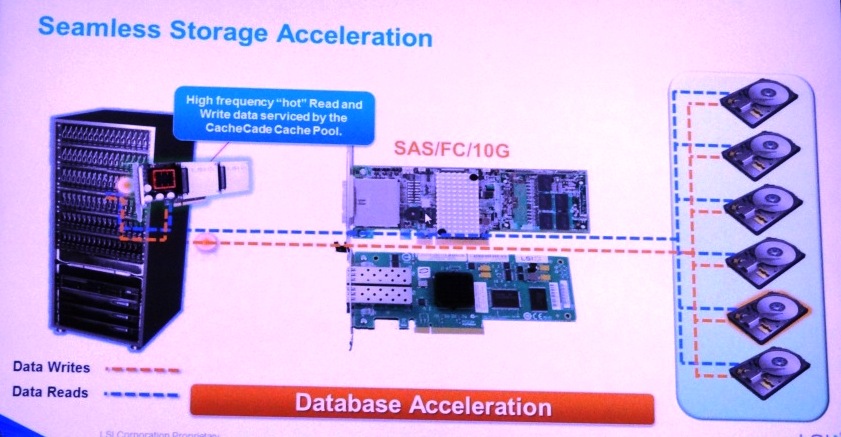Following our popular CacheCade Pro V2.0 article, we have received many emails and questions from interested readers about various aspects of the application of this new type of system acceleration. One of the recurring themes has been, can we cache volumes from anywhere in the system or do they have to be physically connected to the controller?
With the version of CacheCade currently available, all logic of the caching algorithms are contained on the card itself so the ability to cache ‘remote’ volumes/LUNs inside the same system is not possible.
I was pleased when we came across a demonstration of yet another advance that LSI is developing in tandem with the WarpDrive series of devices and it far exceeds ‘just’ the ability to cache all volumes in the server.
 With caching logic being moved into the host system, there are plans to cache many forms of traffic with a CacheCade implementation. This includes SAS, Fibre Channel, and 10G communications. This future usage model will involve a WarpDrive module at the heart of the operation, caching all of these connected devices.
With caching logic being moved into the host system, there are plans to cache many forms of traffic with a CacheCade implementation. This includes SAS, Fibre Channel, and 10G communications. This future usage model will involve a WarpDrive module at the heart of the operation, caching all of these connected devices.
The implications for this are numerous as right now there is an increasing amount of traffic congestion in server networks so the caching of these different forms of traffic can be a very useful tool that could solve a large number of issues in the data center.
This technology, while not in its infancy as they did have a working demo, is definitely still in the early stages. There wasn’t a whole lot of information shared on the technology and the application, as we did ask! There just is not a lot of information that LSI is willing to disclose at this point.
The key takeaway here is that LSI certainly is not being shy with its plans for the WarpDrive, moving its capabilities much further by leveraging its CacheCade technology in tandem with the device.
 One of the pervasive elements that seemed to permeate the atmosphere at the summit is a palpable air of excitement around the team at LSI. They are very passionate about their innovations, and it shows.
One of the pervasive elements that seemed to permeate the atmosphere at the summit is a palpable air of excitement around the team at LSI. They are very passionate about their innovations, and it shows.
Identifying problems and solutions for all levels of their customers is certainly a big motivation. There is a willingness to innovate and a desire to revolutionize the data tree and we look to see many more exciting technologies emerging from this company in the near future.
With the acquisition of an existing partner, SandForce, there is a sense that even greater things are coming soon, especially in the flash acceleration division.
With a prototype of this device headed its way towards our test bench, be sure to come back for a much more intense look at the nuts and bolts of this devices operation, and some exciting performance results!
 The SSD Review The Worlds Dedicated SSD Education and Review Resource |
The SSD Review The Worlds Dedicated SSD Education and Review Resource | 